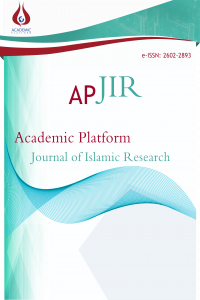Al-Quds in Arabic Literature in the Twentieth Century
By tracing Al-Quds’ litetature in the twentieth century، some conclusions can be made. The poetry about
Jerusalem included three domains، namely religious، patriotic and social poetry. It is also shown that religious
poetry focuses on showing the importance of Al-Quds and its distinguished holy places. A lot of this poetry was
written on famous religious and historical occasions، such as Israa’ and Mirac، the prophet’s birth and
emigration. On the other hand، the patriotic poems were written about the Arab conflict with the enemy. It
described the Palestinian’s consecutive revolutions، especially the period prior to 1948 Palestinian Nakba. After
Al Nakba، however، poems kept focusing on liberating the holy places and rescuing them from occupation via
the enthusiasm and the empathy of poets toward Jerusalem، which was occupied by the enemy. Al-Quds was
clearly present in the poetry، stories and novels، while it was not as such in plays. Many writers and poets were
keen on highlighting reality in their literature، which was related to Al-Quds. They pictured reality
photographically when they talked about the event that happened in Al-Quds in the twentieth century; they
described the battles with the Jews during and after Nakba; they mentioned some of the courageous actions of
the Palestinians against their enemy. Recording reality was reflected in the image of Al-Quds in this literature.
So، Al-Quds appeared as a stable place. Some writers and poets were able to draw a clear picture of the main
features of Al-Quds in their literature. Therefore، it appeared as a bright and shiny place، which is full of life and
energy. Some of those stories were those of Najati Sidqi، Ameen Faris Melhasi، Khalil Al Sawahri and Ibrahim
Al Daqqaq. Al-Quds in “Sudasiyat Al-Ayyam Al-Sittah” for Emile Habibi، became an important human cause.
Across Palestine، Al-Quds was in the heart of everybody. And it did not lose its uniqueness in the distinguished
novels. By studying Al-Quds literature during the 20th century، we can conclude that the literature was in two
levels: the first level includes the incidental rejection to the reaction towards the events related to Al-Quds. The
literature of this level was weak because it did not have the power to revive the heritage and the sufferings of the
moment. These creative works were weak because they have powerful and meaningful vocabulary; they were
imitating the Abbasi poets or modern poets. Al-Quds poet were affected. The second level represents those poets
who had a more comprehensive view about their stance against the occupier، and they were those who had a
reaction، and sacrificed their literature for the sake of giving Al-Quds a very special taste and value.
Anahtar Kelimeler:
Al-Quds, Arabic Literature, Twentieth Century
Al-Quds in Arabic Literature in the Twentieth Century
By tracing Al-Quds’ litetature in the twentieth century، some conclusions can be made. The poetry about
Jerusalem included three domains، namely religious، patriotic and social poetry. It is also shown that religious
poetry focuses on showing the importance of Al-Quds and its distinguished holy places. A lot of this poetry was
written on famous religious and historical occasions، such as Israa’ and Mirac، the prophet’s birth and
emigration. On the other hand، the patriotic poems were written about the Arab conflict with the enemy. It
described the Palestinian’s consecutive revolutions، especially the period prior to 1948 Palestinian Nakba. After
Al Nakba، however، poems kept focusing on liberating the holy places and rescuing them from occupation via
the enthusiasm and the empathy of poets toward Jerusalem، which was occupied by the enemy. Al-Quds was
clearly present in the poetry، stories and novels، while it was not as such in plays. Many writers and poets were
keen on highlighting reality in their literature، which was related to Al-Quds. They pictured reality
photographically when they talked about the event that happened in Al-Quds in the twentieth century; they
described the battles with the Jews during and after Nakba; they mentioned some of the courageous actions of
the Palestinians against their enemy. Recording reality was reflected in the image of Al-Quds in this literature.
So، Al-Quds appeared as a stable place. Some writers and poets were able to draw a clear picture of the main
features of Al-Quds in their literature. Therefore، it appeared as a bright and shiny place، which is full of life and
energy. Some of those stories were those of Najati Sidqi، Ameen Faris Melhasi، Khalil Al Sawahri and Ibrahim
Al Daqqaq. Al-Quds in “Sudasiyat Al-Ayyam Al-Sittah” for Emile Habibi، became an important human cause.
Across Palestine، Al-Quds was in the heart of everybody. And it did not lose its uniqueness in the distinguished
novels. By studying Al-Quds literature during the 20th century، we can conclude that the literature was in two
levels: the first level includes the incidental rejection to the reaction towards the events related to Al-Quds. The
literature of this level was weak because it did not have the power to revive the heritage and the sufferings of the
moment. These creative works were weak because they have powerful and meaningful vocabulary; they were
imitating the Abbasi poets or modern poets. Al-Quds poet were affected. The second level represents those poets
who had a more comprehensive view about their stance against the occupier، and they were those who had a
reaction، and sacrificed their literature for the sake of giving Al-Quds a very special taste and value.
Keywords:
Al-Quds, Arabic Literature, Twentieth Century,
___
- براهن الدين العبوشي، إىل مىت، مطبيه المعارف بغداد 1972م
- Yayın Aralığı: Yılda 3 Sayı
- Başlangıç: 2017
- Yayıncı: Akademik Perspektif Derneği
Sayıdaki Diğer Makaleler
Jerusalem from the Perspective of Orientalist Travelers and Critical Studies
Jerusalemin Visual Drama in the East and West
Türkiye’de bir Kudüs Şairi: Nuri Pakdil ve Aşk-ı Kudüs
Al-Quds in Arabic Literature in the Twentieth Century
Jerusalem Between Torah and History
The Image of Al Quds in the Eyes of the French Author Gustave Flaubert
